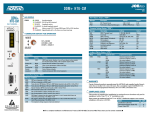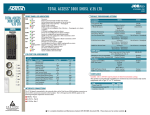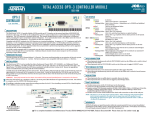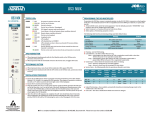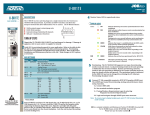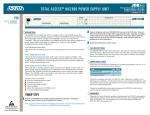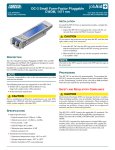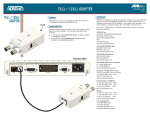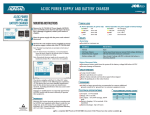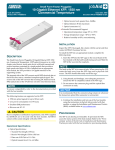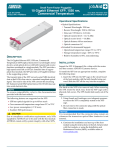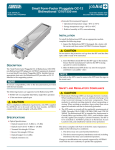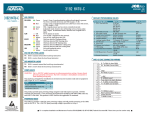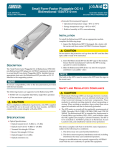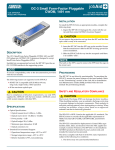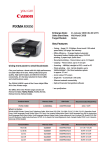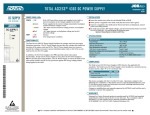Download ADTRAN HTU-C / 3192 User's Manual
Transcript
JOBAID HTU-C / 3192 HTU-C / 3192 CLEI: T1L4SNSC_ _ STATUS LEDs LP1 / LP2 ● OFF DSX ● ● ● ✷ ● ✷ ● ● ● RED YELLOW GREEN FLASHING OFF FLASHING GREEN OFF RED ● ● ✷ ● YELLOW OFF FLASHING YELLOW HTU-C 1245004L6 H D S L LP1 LP2 DSX ALM ALM LBK C L O S AIS LBK CDI LBK CIRCUIT BOARD ROTARY SWITCH - SW2 No synchronization between the HTU-C and the next HDSL unit (HRE or HTU-R) on loop1 / loop2 Poor signal quality on loop1 / loop2 Marginal signal quality loop on loop1 / loop2 Good signal quality on loop1 / loop2 Error detected at HTU-C or HTU-R DSX-1 signal not detected BPV, Frame Error (SF), CRC Error (ESF) is detected DSX-1 signal is present and synchronized No alarm condition detected Local alarm condition detected (HTU-C), or local and remote alarm condition detected (HTU-C and HTU-R) Remote alarm condition detected (HTU-R) No active loopback Armed but not in loopback Local loopback is active FACEPLATE SWITCH - SW1 Selects response of HTU-R upon Customer Loss of Signal EXT ALM AIS ■ HTU-R generates unframed all 1s toward network upon loss of customer signal LBK ■ HTU-R generates loopback towards network upon loss of customer signal CDI ■ HTU-R generates framed all 1s toward network upon loss of customer signal EN AMI FT1 EN TX RX R S 2 3 2 C A U T I O N ! SUBJECT TO ELECTROSTATIC DAMAGE OR DECREASE IN RELIABILITY. HANDLING PRECAUTIONS REQUIRED. Selects the DSX-1 Line Build Out ■ 0..........0 - sets LBO to 0-133 feet ■ 1..........133 - sets LBO to 133-266 feet ■ 2..........266 - sets LBO to 266-399 feet ■ 3..........399 - sets LBO to 399-533 feet ■ 4..........533 - sets LBO to 533-655 feet Note: Positions 5,6 & 7 are not used. CIRCUIT BOARD JUMPER - P1 Selects the span powering voltage LV (–140 Vdc) ■ Used to span power circuit with 0 or 1 HRE HV (–190 Vdc) ■ Used to span power circuit with multiple HREs CIRCUIT BOARD JUMPER - P3 Selects the framing of the HDSL circuit LBK TM OUT DIS BZS T1 DIS 61245004L6-22B 0104 FACEPLATE SWITCH - SW3 COMPLIANCE CODES Loopback Timeout Enabled ■ Loopback timeout is enabled Disabled ■ Loopback timeout is disabled Manual Line Code Select AMI ■ AMI line code is selected B8ZS ■ B8ZS line code is selected Latching Loopback T1 ■ Allows only standard T1 testing FT1 ■ Allows for fractional T1 testing External Alarm Enabled ■ External alarm is enabled Disabled ■ External alarm is disabled This product complies with UL 1459, third edition. It is intended to be installed in an enclosure with an Installation Code (IC) of “B” or “E” and in Restricted Access Locations only. Input current at maximum load is 1 A, and maximum output at overcurrent condition is 160 mA at -188 Vdc. Code Installation Code (IC) Telecommunication Code (TC) Power Code (PC) Input Output A – – X F C UNF ■ HTU-C operates in unframed mode AUTO ■ HTU-C auto detects framing DSX EQ BANTAM JACKS Provides an intrusive test access point to the data stream TX ■ Accesses the data stream being received from the local loop RX ■ Accesses the data stream being transmitted to the local loop RS-232 DB-9 CONNECTOR ■ ■ ■ Used to access performance monitoring data, perform loopbacks and provision units via VT100 emulation software such as Hyper Terminal – Private Edition and ProComm Plus. Provision terminal port as follows: Data Rate — 19.2 kbps Asynchronous Data Format — eight data bits, no parity (none), one stop bit When using a PC with terminal software, be sure to disable any power saving programs. WARRANTY Warranty for Carrier Networks products manufactured by ADTRAN and supplied under Buyer’s order for use in the U.S. is ten (10) years. For a complete copy of ADTRAN’s U.S. Carrier Networks Equipment Warranty: (877) 457-5007, Document #414. For complete Installation and Maintenance: (877) 457-5007, Document #300. Please have your fax number available. Pricing and Availability 800.827.0807 Tech Support 800.726.8663 Return for Repair 256.963.8722 www.adtran.com 61245004L6-22B TURN-UP & TROUBLESHOOTING GUIDE INSERTION LOSS MEASUREMENTS Frequency (kHz) Maximum Loss Data (dB) 10000 50000 100000 150000 196000 200000 15.00 25.50 30.00 32.75 35.00 35.25 NOTE: If your TIMs is unable to transmit 200 kHz tone, set the TIMs to one of the frequencies shown above and compare the received signal to the maximum loss at that frequency. HTU-C Open at Frame HV Open at Frame LV HTU-C LV / HTU-R HTU-C LV / HRE1 / HTU-R HTU-C HV / HRE 2 / HTU-R VMDF A t-t Voltage 185 - 190 145 - 150 145 - 150 130 - 135 185 - 190 HRE 1 B t-t Voltage N/A N/A 145 - 150 110 - 135 160 - 185 HRE2 C t-t Voltage N/A N/A 130 - 145 110 - 135 160 - 185 D t-t Voltage N/A N/A N/A N/A 140 - 185 HTU-R E t-t Voltage N/A N/A N/A N/A 140 - 185 F t-t Voltage N/A N/A 125 - 130 100 - 135 130 - 185 NOTE: All measurements taken with HTU-C installed. With the HTU-C unseated or with protector removed at VMDF, t-r resistance will be cable resistance plus 3 ohms (for either HRE or HTU-R). Turn-up Guide 1. Set option switches according to circuit design and local practice. 2. Install HTU-C and HTU-R. 3. See reverse side of this job aid to ensure all LEDs are correct and synchronization has occurred. a) HTU-C will have red ALM LED if not connected to network. LP1 and LP2 should be solid green. b) HTU-R will have red ALM LED if no customer connected. LP1, LP2, line coding and framing (if not UNFR) LEDs should be illuminated. 4. If all LEDs are correct: a) Verify that the signal quality is the same on each loop. Ensure signal quality indicators do not fluctuate. b) Verify that the loop loss is within design limits. If there is a difference of more than 1 dB between the two loops, a problem exists with the cable pairs. c) If errors occur, use the Current System Status and Performance History screens to determine where they are occurring. See Troubleshooting Guide section. 5. If everything checks out, proceed with BERT testing. Troubleshooting Guide The HTU-C DSX LED is Flashing, but no Errors are Indicated by the HTU-R ■ A BPV, Frame Error (SF) or CRC Error (ESF) has been detected at the DSX-1 interface. Possible network or wiring problem between the HTU-C and the DSX. This is not an indication of problems on the HDSL loops. The HTU-R DS1 LED is Flashing, but no Errors are Indicated by the HTU-C ■ A BPV, Frame Error (SF) or CRC Error (ESF) has been detected at the DS1 interface. This indicates a wiring problem or a B8ZS/AMI mismatch between the HTU-R and the customer equipment. This is not an indication of problems on the HDSL loops. The HTU-R has Power, but LP1 and LP2 LEDs are Dark. The Unit cannot Sync with the HTU-C ■ Simplex power for powering the HTU-R can be passed over cable pairs that contain load coils or that are too long for HDSL synchronization. Using a TIMs, verify the circuit is within design limits. ■ The HTU-R will power up as long as there is at least one good conductor on each loop. To test, remove the protector plug at the MDF and measure t-r resistance to the HTU-R on both loops. The HTU-R will place a 3 ohm short between t-r on both loops. An extremely high impedance indicates an open conductor. An extremely low reading on one loop may indicate a t-r short in the field. In the field, measure t-t and t-r voltage with the HTU-C installed and compare to the chart above. If these voltages are not present, open pairs or mis-wiring is indicated. As with other circuits, standard resistance measurements between each conductor and ground should also be used to test for a grounded conductor. ■ If the HTU-C is optioned for LV and there are two HREs in the circuit, the HTU-R could fail to power up normally. The LEDs on the HREs or HTU-R will flash at a rate of 3 times/second. Make sure the voltage option on the HTU-C is set to HV. ■ A high resistance open which degrades to the point that it causes the circuit to lose sync can be “resealed” by reseating the HTU-C. Test the cable pairs before reseating the HTU-C. Running Excessive Errors on the Loop ■ Measure t-r resistance as described above. If the pairs are unbalanced by more than 4 ohms, or a measurement varies a great deal, this could indicate a high resistance open or an intermittent fault on the loop with the higher measurement. A TDR is typically required to locate this splice for repair. ■ Excessively long bridged taps can also cause errors. Check the records and/or use a TDR to verify the location and length of bridged taps. ■ Using ADTRAN’s “Performance History” screen, it is often possible to see that many more errors are being received on a particular loop or at a particular unit. The fault will typically be very close to the unit receiving the most errors. No Power at the HTU-R ■ This could be caused by a loop with two open conductors. Measure t-r resistance from the MDF to the HTU-R or use the voltage chart to see which pair is open. ■ Check the HV/LV option on the HTU-C and re-option if necessary.


